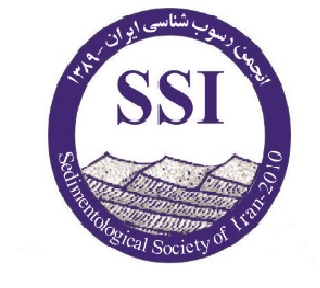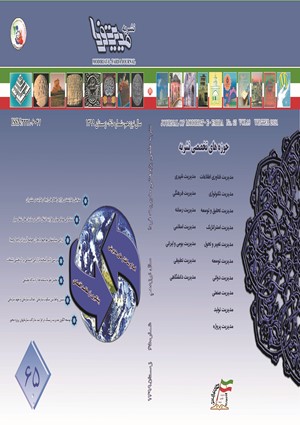Exploring and Explaining the Antecedents of Emotional Climate of Organization in National Iranian Oil Products Distribution Company
Subject Areas :
Mohammad Hossein Dehnavi
1
,
ali shirazi
2
,
Shamsodin Nazemi
3
,
fariborz rahimnia
4
![]()
1 - ferdousi university
2 - ferdousi university
3 - ferdousi university
4 - ferdousi university
Keywords: Organizational Climate Emotional Climate of Organization Qualitative Content Analysis Emotions,
Abstract :
The main aim of this study is to explore and explain the antecedents of emotional climate of organization, and to introduce its components in National Iranian Oil Products Distribution Company (Khorasan Razavi). This is a qualitative research study, which is based on content analysis strategy. The data were collected through semi - structured interviews, and the analysis was done by the qualitative content analysis. The statistical population consisted of all employees of National Iranian Oil Products Distribution Company in Khorasan Razavi District, and the sample was selected by using purposeful sampling up to the theoretical saturation and sampling adequacy of 19 people. The findings showed that the antecedents of the emotional climate of organization can be grouped into seventeen categories, including manager’s characteristics, meritocracy, respecting employees, corporate reputation, political parties, self-interest, ranking system, privatization, administrative rules, compensation system, organizational ethics, external environment of the organization, organizational justice, knowledge management, conflict, type of work, and job rotation. Recognition of these antecedents and their sub components can help the managers to better understand their organization and make necessary changes to provide a well-managed emotional climate in line with the organizational goals.
منابع فارسی 1. تبریزی، منصوره(1393). تحلیل محتوای کیفی از منظر رویکردهای قیاسی و استقرایی. فصلنامه علوم اجتماعی. شماره 64، بهار.
2. باردن، لورانس(1374). تحلیل محتوا. ترجمه محمد یمنیدوزی سرخابی، ملیحه آشتیانی. تهران.مرکز چاپ و انتشارات دانشگاه شهید بهشتی.
3.حافظ نیا؛محمدرضا(1387). مقدمهای بر روش تحقیق در علوم انسانی. چاپ چهاردهم. تهران:سمت.
4. رنجبر،هادی؛حقدوست،علیاکبر؛صلصالی، مهوش؛ خوشدل،علیرضا؛سلیمانی،محمدعلی؛ بهرامی،نسیم(1391). مجله علمی پژوهشی دانشگاه علوم پزشکی ارتش جمهوری اسلامی ایران، سال دهم، شماره سوم، ص 250-238.
5.نوشادی، ایمان (1390). تحلیل محتوای کیفی. پژوهش، سال سوم، شماره دوم، ص 44-15.
منابع انگلیسی 1. Ashkanasy, N. M., & Humphrey, R. H. (2011). Current emotion research in organizational behavior. Emotion Review, 3(2), 214-224.doi: https://doi.org/10.1177/1754073910391684 2. Ashkanasy, N. M., & Nicholson, G. J. (2003). Climate of fear in organizational settings: Construct definition, measurement and a test of theory. Australian Journal of Psychology, 55(1), 24-29.doi: https://doi.org/10.1080/00049530412331312834. 3. Ashkanasy, N. M., Wilderom, C. P., & Peterson, M. F. (2000). Handbook of Organizational Culture and Climate. Sage. doi: : http://dx.doi.org/10.4135/9781483307961. 4. Ashton-James, C. E., & Ashkanasy, N. M. (2008). Chapter 1 Affective events theory: a strategic perspective. In Emotions, Ethics and Decision-Making (pp. 1-34). Emerald Group Publishing Limited. https://www.emeraldinsight.com/doi/abs/10.1016/S1746-9791%2808%2904001-7?fullSc=1 5. Capara, G. V., Barbaranelli, C., & Zimbardo, P. G. (1999). Personality profiles and political parties. Political Psychology, 20 (1), 175-197. doi:http://dx.doi.org/10.1111/0162-895X.00141 6. Carlson, D. S., & Perrewe, P. L. (1995). Institutionalization of organizational ethics through transformational leadership. Journal of Business Ethics, 14(10), 829-838. doi: https://doi.org/10.1007/BF00872349 7. Ho, W. H., Chang, C. S., Shih, Y. L., & Liang, R. D. (2009). Effects of job rotation and role stress among nurses on job satisfaction and organizational commitment. BMC Health Services Research, 9(1), 8. doi: https://doi.org/10.1186/1472-6963-9-8 8. Cropanzano, R., Bowen, D. E., & Gilliland, S. W. (2007). The management of organizational justice. Academy of management perspectives, 21(4), 34-48.doi: https://doi.org/10.5465/amp.2007.27895338 9. Curşeu, P. L., & Schruijer, S. G. (2010). Does conflict shatter trust or does trust obliterate conflict? Revisiting the relationships between team diversity, conflict, and trust. Group Dynamics: Theory, Research, and Practice, 14(1), 66.doi: http://dx.doi.org/10.2139/ssrn.1100581 10. Damanpour, F., & Schneider, M. (2008). Characteristics of innovation and innovation adoption in public organizations: Assessing the role of managers. Journal of public administration research and theory, 19(3), 495-522. https://doi.org/10.1093/jopart/mun021 11. Daniels, N. (1978) Merit and meritocracy. Philosophy and Public Affairs, 3, 206–223. 12. De Rivera, J. (1992). Emotional climate: Social structure and emotional dynamics. In A preliminary draft of this chapter was discussed at a workshop on emotional climate sponsored by the Clark European Center in Luxembourg on Jul 12–14, 1991.. John Wiley & Sons. http://www2.clarku.edu/faculty/ derivera/ emotionalclimate.doc 13. Diab, S. M. (2015). The Impact of organizational justice on the workers performance and job satisfaction in the ministry of health hospitals in amman. International Business Research, 8(2), 187.doi: 10.5539/ibr.v8n2p187 14. Elo, S., Kääriäinen, M., Kanste, O., Pölkki, T., Utriainen, K., & Kyngäs, H. (2014). Qualitative content analysis: A focus on trustworthiness. SAGE open, 4(1), 2158244014522633. 15. El-Said, O. A. (2014). Impacts of respect, support, and teamwork on hotel employees' morale in Egypt. Anatolia, 25(2), 211-227. doi: https://doi.org/10.1080/13032917.2013.856330 16. Feibleman, J., & Friend, J. W. (1945). The structure and function of organization. The Philosophical Review, 54(1), 19-44. 17. Fisher, C. D. (2010). Happiness at work. International Journal of Management Reviews, 12(4), 384-412. doi: https://doi.org/10.1111/j.1468-2370.2009.00270.x 18. Hansen, H., Samuelsen, B. M., & Silseth, P. R. (2008). Customer perceived value in BtB service relationships: Investigating the importance of corporate reputation. Industrial Marketing Management, 37(2), 206-217.doi: https://doi.org/10.1016/j.indmarman.2006.09.001 19. Hartel, C., Ashkanasy, N. M., & Zerbe, W. (Eds.). (2005). Emotions in organizational behavior. Psychology Press. 20. Härtel, C. E., Gough, H., & Härtel, G. F. (2008). Work-group emotional climate, emotion management skills, and service attitudes and performance. Asia Pacific Journal of Human Resources, 46(1), 21-37.doi: https://doi.org/10.1177/1038411107086541. 21. Kanyangara, P., Rimé, B., Philippot, P., & Yzerbyt, V. (2007). Collective rituals, emotional climate and intergroup perception: Participation in “Gacaca” tribunals and assimilation of the Rwandan genocide. Journal of Social Issues, 63(2), 387-403.doi: https://doi.org/10.1111/j.1540-4560.2007.00515.x 22. King, W. R. (2009). Knowledge management and organizational learning. In Knowledge management and organizational learning (pp. 3-13). Springer, Boston, MA. doi: https://doi.org/10.1007/978-1-4419-0011-1_1 23. Liu, X. Y., Härtel, C. E., & Sun, J. J. M. (2014). The workgroup emotional climate scale: Theoretical development, empirical validation, and relationship with workgroup effectiveness. Group & Organization Management, 39(6), 626-663.doi: https://doi.org/10.1177/1059601114554453 24. Mark, S., Philip, L., & Adrian, T. (2009). Research Methods for Business Students. http://eprints.stiperdharmawacana.ac.id/id/eprint/189. 25. Mason, R. B. (2007). The external environment's effect on management and strategy: a complexity theory approach. Management decision, 45(1), 10-28.doi: https://doi.org/10.1108/ 00251740710718935 26. Miller, D. T. (2001). The norm of self-interest. In The next phase of business ethics: Integrating psychology and ethics (pp. 193-210). Emerald Group Publishing Limited. 27. Priest, G. L. (1988). Introduction: The aims of privatization. Yale Law & Policy Review, 6(1), 15. 28. Páez, D., Ruiz, J. I., Gailly, O., Kornblit, A., Wiesenfeld, E., & Vidal, C. M. (1996). Trauma Políticoy clima emocional: una investigación transcultural. Psicología Política, 12, 47-69. 29. Pirola-Merlo, A., Härtel, C., Mann, L., & Hirst, G. (2002). How leaders influence the impact of affective events on team climate and performance in R&D teams. The Leadership Quarterly, 13(5), 561-581.doi: https://doi.org/10.1016/S1048-9843(02)00144-3 30. Pirson, M., & Malhotra, D. (2011). Foundations of organizational trust: What matters to different stakeholders?. Organization Science, 22(4), 1087-1104.doi: https://doi.org/10.1287/ orsc. 1100.0581 31. Ruiz, J. I. (2007). Emotional climate in organizations: applications in Latin American Prisons. Journal of Social Issues, 63(2), 289-306.doi: https://doi.org/10.1111/j.1540-4560.2007. 00509.x 32. Shaery-Eisenlohr, R. (2007). Imagining Shi ‘ite Iran: Transnationalism and Religious Authenticity in the Muslim World. Iranian Studies, 40(1), 17-35. 33. Silverman, D. (2005, September). Instances or sequences? Improving the state of the art of qualitative research. In Forum Qualitative Sozialforschung/Forum: Qualitative Social Research (Vol. 6, No. 3).doi: http://dx.doi.org/10.17169/fqs-6.3.6 34. Spiess, J. K. A. (2011). The Effect of Emotional Climates in Leader-Follower and Employee-Customer Relationships in a Service Context (Doctoral dissertation, University of St. Gallen). http://verdi.unisg.ch/www/edis.nsf/SysLkpByIdentifier/3936/$FILE/dis3936.pdf 35. Yurtsever, G., & de Rivera, J. (2010). Measuring the emotional climate of an organization. Perceptual and Motor Skills, 110(2), 501-516. doi:https://doi.org/10.2466/pms.110.2.501-516 .

